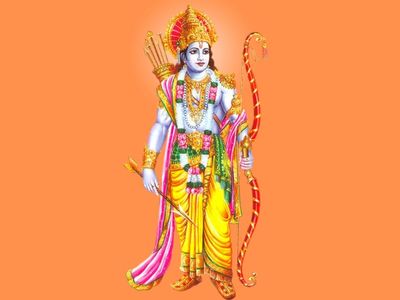
|
Getting your Trinity Audio player ready...
|
Ram’s greatest qualities that made him Maryada Purushottam were manifest not when he was in Ayodhya, the centre of power, but when in exile in the forests.
It is said that there won’t be a village in India without a Ram temple. Ram is a universal deity, “treasured as the common property of every Hindu – as well as that of many Muslims, Sikhs, Buddhists, Jains, and Christians”, as historian William Dalrymple puts it. It is easy to relate with Ram, because, as aptly described by sage Valmiki, the author of Ramayana, he was an avatar of Vishnu as well as an ordinary, yet ideal human being. It is this relatability that has made Ram and Ramayana the most popular epic hero and epic poem in the world. Robert Goldman, the Sanskrit professor from University of California observes that, “Few works of literature produced in any place at any time have been as popular, influential, imitated and successful as the great and ancient Sanskrit epic poem, the Valmiki Ramayana.”
All religions, Semitic or Eastern, have sacredness attached to spaces and heroes. The Romanian scholar of religion at the University of Chicago, Mircea Eliade, had coined the term “hierophany”, meaning the sacredness attached to places brushed by God’s presence. For the Jews, the Wailing Wall in Jerusalem, believed to belong to the temple built by King Solomon in 10th century BCE is sacred, while it is Jerusalem for the Christians, because of its association with Jesus from childhood until after resurrection. For the Muslims, Mecca is sacred as the birthplace of the prophet. Even the Greeks still attach sacredness to classical Greek sites like the shrine of Apollo at Delphi or the temple of Artemis at Ephesus, the ancient Greek city, now in Turkey.
In the same manner Hindu deities too have their sacred history and places. Hindu gods are the primary unifiers of the Hindu nation. Ram and Krishna, the greatest epic heroes of Hinduism, traversed the length and breadth of Bharat. Ram journeyed from north to south, while Krishna travelled from west to east (and also from Mathura to Dwaraka in Gujarat). Numerous sacred places dot the geography of India linked to the history of these two hallowed figures. Temples were built for them, and in some cases, by them too. The deity of Shiva in Rameswaram in the south is believed to have been installed by Shri Ram himself.
These temples represent their connection with gods at one level, while they diffuse noble values that the gods represented at another. It is that hoary value system that binds the Hindu society together. Ram Manohar Lohia, the eminent socialist thinker of the last century, regarded Ram, Krishna and Shiva as the greatest symbols of the ancient Indic civilisation. ‘You stand outside any temple dedicated to them. You will find a mini Hindustan there’, he used to say. From Kashi, Mathura and Ayodhya in the north to Tirupati and Rameswaram in the south, from Guwahati in the far east to Dwaraka in the far west, every place dedicated to them is sacred to Indians.
Lohia’s Ram was an ideal human being. Swami Vivekananda too described Ram as “the embodiment of truth, of morality, the ideal son, the ideal husband, and above all, the ideal king”. For Mahatma Gandhi, Ram enshrined truthfulness.
In the Aranyakaand of the Ramayana, the demon Mareecha, when asked by Ravana to disguise as a golden deer to distract Ram, warns Ravana against the misadventure by describing Ram as रामो विग्रहवान् धर्मस्साधुस्सत्यपराक्रमः – meaning, Ram was the embodiment of Dharma; a pious man with truth as his power.
Valmiki used two phrases to describe the ideal human being Ram – ‘Vigrahvaan Dharmah’ and ‘Maryadaa Purushottam’ – epitome of Dharma and morals.
Ram became great not when he was ruling, but when he was struggling. Virtuous are those who are undisturbed when out of power. Ram’s greatest qualities that made him Maryada Purushottam were manifest not when he was in Ayodhya, the seat of royal power, but when in exile in the forests. His finest qualities of humility, magnanimity and fortitude came out during various incidents of the Vanvas – life in the forest. Ram’s highpoint was his respect for Ravana. He bows before him in reverence for his scholarship when they come face to face in the battlefield on the first day. When Ravan was on his deathbed, Ram sends Lakshman to learn some noble lessons. Lakshman comes back saying Ravan refused to teach any. Having learnt the minute details of the meeting Ram scolds Lakshman for standing at Ravan’s head and sends him back with the instruction that he should beseech guidance by standing at Ravan’s feet.
Ram’s low point was when he asked Sita to undergo Agni Pariksha – fire test. Ram’s excuse is that society needs to be convinced about her chastity. Sita admonishes him for a lack of manliness. But for Ram, ‘people first’ was Ram Rajya, as Gandhi described it.
Hinduism is a worship-centric religion. Everything, animate and inanimate alike, is worshipped here. Sacredness of everything in creation – the omnipresence of divinity is the essence of Hinduism. Power, for Ram, was also an object of worship. Sage Valmiki used two significant phrases in Ramayana to describe Ram’s rule. They were – ‘Raamo Raajyamupaasitva’ (Ram worshipped his kingdom); and ‘Aaraadhanaaya Lokasya’ (worship of the people).
स्नेहं दयां च सौख्यं च यदि वा जानकीमपि । आराधनाय लीकस्य मुँचतो नास्ति में व्यथा।।
Says Ram when time came to leave Sita forever. In other words, ‘for the worship of my people, I can leave my love, kindness, all kinds of pleasures and even Sita’. Ram was known for his affection and kindness. Ram and Sita are held as the epitome of love. Yet, Ram says he was ready to give up his most important qualities, not for the sake of power, but ‘Aaradhanaya Lokasya’ – to worship people.
There are many great lessons that one can learn from Ram and Ramayana. But the greatest is reserved for the rulers – humility, not arrogance of power, is the way to worship kingdom and people. That was the kind of Ram Rajya that Gandhi wanted for India post independence.
He wrote in Harijan in January 1937 that: “By political independence I do not mean an imitation to the British House of commons, or the soviet rule of Russia or the Fascist rule of Italy or the Nazi rule of Germany. They have systems suited to their genius. We must have ours suited to ours. What that can be is more than I can tell. I have described it as Ramarajya i.e., sovereignty of the people based on pure moral authority”.
(The article was originally published by Chintan – India Foundation Blogs on November 23, 2020. Views expressed are personal.)



